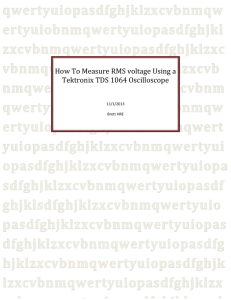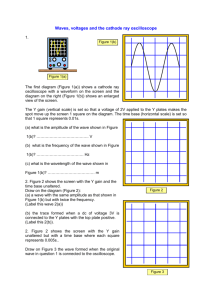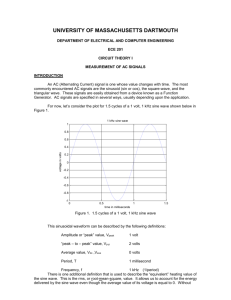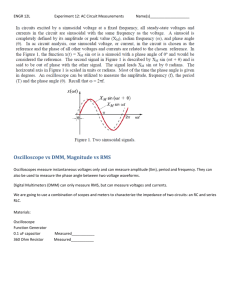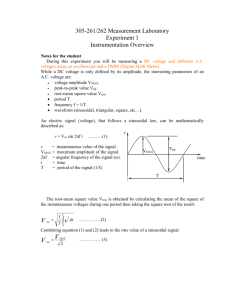Lab 05 AC Signal measurement
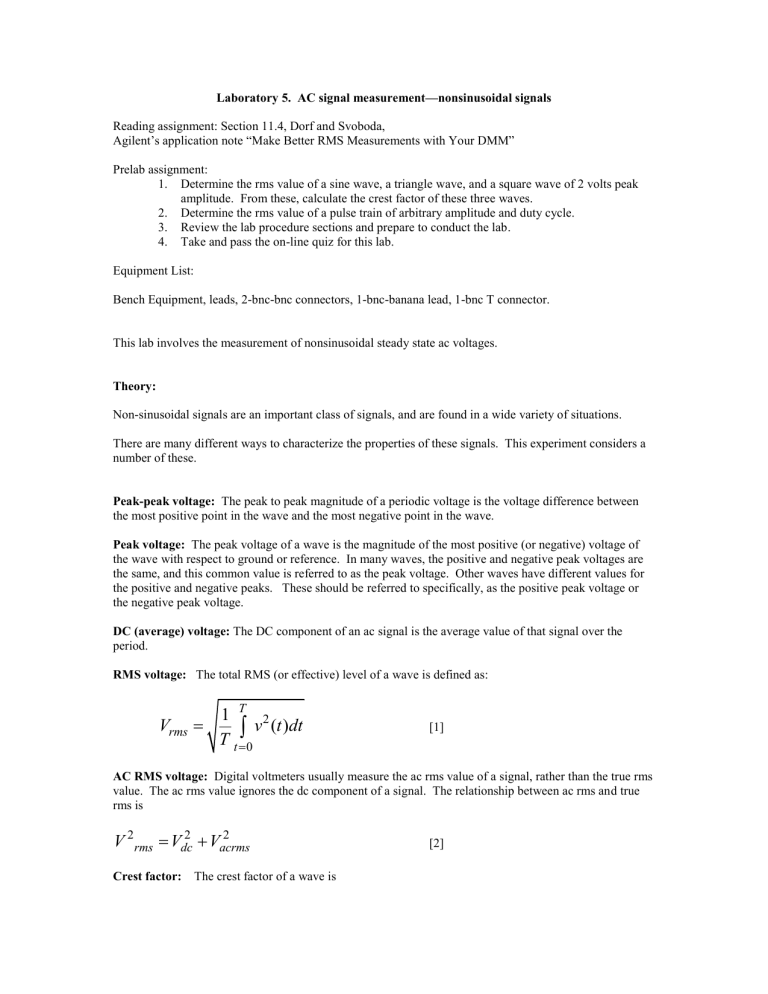
Laboratory 5. AC signal measurement—nonsinusoidal signals
Reading assignment: Section 11.4, Dorf and Svoboda,
Agilent’s application note “Make Better RMS Measurements with Your DMM”
Prelab assignment:
1.
Determine the rms value of a sine wave, a triangle wave, and a square wave of 2 volts peak amplitude. From these, calculate the crest factor of these three waves.
2.
Determine the rms value of a pulse train of arbitrary amplitude and duty cycle.
3.
Review the lab procedure sections and prepare to conduct the lab.
4.
Take and pass the on-line quiz for this lab.
Equipment List:
Bench Equipment, leads, 2-bnc-bnc connectors, 1-bnc-banana lead, 1-bnc T connector.
This lab involves the measurement of nonsinusoidal steady state ac voltages.
Theory:
Non-sinusoidal signals are an important class of signals, and are found in a wide variety of situations.
There are many different ways to characterize the properties of these signals. This experiment considers a number of these.
Peak-peak voltage: The peak to peak magnitude of a periodic voltage is the voltage difference between the most positive point in the wave and the most negative point in the wave.
Peak voltage: The peak voltage of a wave is the magnitude of the most positive (or negative) voltage of the wave with respect to ground or reference. In many waves, the positive and negative peak voltages are the same, and this common value is referred to as the peak voltage. Other waves have different values for the positive and negative peaks. These should be referred to specifically, as the positive peak voltage or the negative peak voltage.
DC (average) voltage: The DC component of an ac signal is the average value of that signal over the period.
RMS voltage: The total RMS (or effective) level of a wave is defined as:
V rms
T
1 t
T
0
( )
[1]
AC RMS voltage: Digital voltmeters usually measure the ac rms value of a signal, rather than the true rms value. The ac rms value ignores the dc component of a signal. The relationship between ac rms and true rms is
V
2 rms
V
2 dc
V
2 acrms
[2]
Crest factor: The crest factor of a wave is
Crest Factor
V peak
V rms
Pulse train measurements:
[3]
Figure 1. Pulse train.
A common set of signals are referred to as pulse trains. A typical pulse train is shown in Figure 1.
Note the following definitions for a pulse train. Pulse trains often have a value of 0 volts during the “off” part of the cycle.
Period T : the time for which the pulse train completes one cycle
Frequency f =1/T
On time Ton : The time for which the pulse train is in it’s “on” state with a value of Von. Measured from the time when the rising edge reaches 50% of it’s on value to the time when the falling edge reaches 50% of this same value.
Duty cycle D =Ton/T
Laboratory Procedure
Part 1. Periodic voltage measurements.
Connect the signal generator to a digital voltmeter (dvm) and to the oscilloscope. Adjust the signal generator to provide a 1 kilohertz sine wave, and adjust the function generator amplitude setting to 2 volts.
Note that simplified instructions for the function generator are included on pull out tabs underneath the instrument.
A.
Set up the oscilloscope and dvm to measure this signal. Use the measurement function on the oscilloscope to determine peak, peak-peak, dc, and rms values. Use the dvm to measure both dc and ac
rms values.
B.
Record the following for the sine wave: peak voltage:______________ peak-peak voltage:____________ oscilloscope rms voltage ________________ dc voltage:__________________ dvm ac rms voltage______________________ dvm dc voltage_______________
Calculate the crest factor for this wave:________________
C.
Switch to the triangle wave. Measure and record: peak voltage_________________ peak-peak voltage______________ oscilloscope rms voltage ________________ dc voltage:__________________ dvm ac rms voltage______________________ dvm dc voltage_______________
Crest factor______________
D.
Switch the function generator so that it provides a square wave signal. Verify on the oscilloscope that the frequency and peak value of the signal has not changed. Record the following: peak voltage_________________ peak-peak voltage______________ oscilloscope rms voltage ________________ dc voltage:__________________ dvm ac rms voltage______________________ dvm dc voltage_______________
Crest factor______________
E.
Adjust the function generator offset setting to 1.0 volts. This should fully offset the square wave, so that the wave should have a minimum value of zero volts. Use the oscilloscope to verify that this is the case. Note that this 1 volt offset setting provides a dc offset of 2 volts—note this idiosyncracy of this function generator, as we will use this setting to provide pulse trains throughout the semester.
Record the following voltages. peak voltage_________________ peak-peak voltage______________ oscilloscope rms voltage ________________ dc voltage:__________________ dvm ac rms voltage______________________ dvm dc voltage_______________
Use the ac rms reading of the dvm and the dc voltage reading, calculate the total rms value of this
wave_________________
How does this compare with the total rms measurement of the oscilloscope?
Has this value changed from the rms value of the square wave with no offset?____________
F.
Adjust the waveform so that the signal generator puts out a pulse train alternating between +5v and zero volts. Verify this on the oscilloscope. Record the function generator settings:
Amplitude = _____________ Offset= ______________.
Adjust the function generator symmetry (duty cycle) between 10% and 90% in 20% increments, and measure the dc voltage and the ac rms voltage for each setting. Theoretically, determine the total rms voltage for each measurement, and verify that the correct combination of these two readings gives you the total rms voltage. Plot the dc, ac rms, and total rms values versus duty cycle. Record your results below. Use the dc and acrms measurements with Eq. 2 to get the calculated rms value, and compare this value with the theoretical value predicted by Eq. 1. Comment on the agreement or lack of agreement between these values.
Duty Cycle Vdc ac rms value total RMS total RMS total RMS
(scope/dvm) (dvm) (scope) (calculated from (prelab prediction)
Dc and ac rms)
10%
30%
50%
70%
90%
G. Compare the three total rms values that are recorded in Part F., and comment on their accuracy.
Part 2. Aperiodic waves—amplitude modulation
1.
Reset the 3314A function generator to put out a 1 volt peak amplitude sine wave with a frequency of
10 kilohertz, with no offset and 50% symmetry. Use channel 1 of the oscilloscope to verify both the amplitude and the frequency of this wave._______________
2.
Locate the function generator on the National Instruments I/O board. The computer must be on for this function generator to be operational. Connect the output of this function generator to channel 2 of the oscilloscope and adjust the controls to provide an 0.5 volt peak sine wave of 125 hertz. In order to do this, change the scope to trigger from Ch. 2 (Select the Trigger Mode/Coupling menu, then select Ch. 2 source.
Measure and record the period of this wave ___________
3.
Connect the NI function generator output to the amplitude modulation (AM) input on the HP 3314A function generator (you no longer need the connection of this signal to Ch 2 of the scope). To activate the am input, press and release the blue pushbutton, and then press the modulation pushbutton. The red AM led should come on.________________
4.
The formula for an amplitude modulated wave is: v o
( t )
V c
[ 1
m a sin(
a t )] sin(
c t ) where: v o
modulated
V c
amplitude
voltage of the carrier wa m a
c
a
ratio of angular angular
the modulating frequency frequency of of ve
wave
the
to the carrier wa
the modulating carrier wa ve
wave ve amplitudes
In practical applications, the amplitude modulation ratio is less than 1, and the frequency of the modulating wave is significantly lower than the carrier frequency.
5.
Set the oscilloscope trigger source to channel 1. The horizontal deflection should be about 1 msec/div. Observe the waveform. Does the observed waveform match the equation given in Step 4?
(You might want to put the oscilloscope Run Control into the “Single” mode. This displays a single trace of the signal. To capture and display a new trace, push “Single” again.)
Extra Credit (2.5%)
1.
The ENVELOPE of a wave is a sketch which links the peaks of the waveform without showing the instantaneous waveform values. Set the amplitude modulation ratio for 0.0, 0.25, 0.5, and 1.0, and sketch the ENVELOPE of these 4 waves below:
2.
Reduce the 3314A frequency gradually until it approaches and passes through the NI signal frequency. What happens to the envelope of the wave as the frequency is reduced?
3.
Observe the behavior of the wave when the signal frequency and carrier frequency are nearly equal.
Comment:
Last modified 1/3/2007 tho
